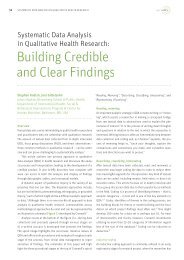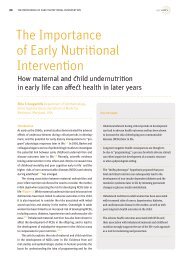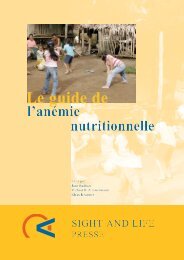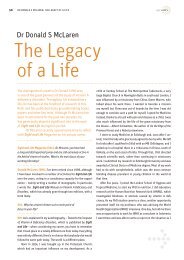48 OPINION 1Opinion 1: Vitamin D Status and TuberculosisHenrik FriisDepartment <strong>of</strong> Human Nutrition, Faculty <strong>of</strong> LifeSciences, University <strong>of</strong> Copenhagen, DenmarkResearch in vitamin D has increased dramatically, mainly dueto the discovery that vitamin D is important not just for bonehealth, but also for a range <strong>of</strong> body functions, and in terms <strong>of</strong>the risk <strong>of</strong> chronic and infectious diseases. While some <strong>of</strong> theresearch is basic science, much is based on observational epidemiology,linking low serum concentrations <strong>of</strong> 25-hydroxyvitaminD (25(OH)D) to various diseases. Since the validity <strong>of</strong> mostmarkers <strong>of</strong> micronutrient status is affected by an acute phaseresponse, the review <strong>of</strong> the validity <strong>of</strong> 25(OH)D by Dr Thurnhamin this issue is timely.The main source <strong>of</strong> vitamin D is sunlight, yet deficiencyseems to be a problem in Asia and Africa, and even in equatorialcountries. 1 The burden <strong>of</strong> infectious diseases is high in lowincome populations, even among apparently healthy individuals.If, indeed, an acute phase response reduces 25(OH)D independent<strong>of</strong> vitamin D status, this will lead to an overestimation <strong>of</strong> theprevalence <strong>of</strong> deficiency, and probably confound the estimates<strong>of</strong> association between 25(OH)D and the various outcomes.Vitamin D and tuberculosisAn area <strong>of</strong> research that illustrates the implications <strong>of</strong> poor validity<strong>of</strong> 25(OH)D in the presence <strong>of</strong> an acute phase responseis the role <strong>of</strong> vitamin D for the risk <strong>of</strong> pulmonary tuberculosis(TB). It is biologically plausible that vitamin D – given its importancefor the immune system – is a determinant <strong>of</strong> TB. 2 However,most research has been based on case-control studies, inwhich 25(OH)D is determined, as a measure <strong>of</strong> vitamin D status,in new cases with TB and in controls. Since TB patients have ahuge acute phase response, any negative effect on 25(OH)D will,hence, either lead to overestimation <strong>of</strong> a true or create a falsenegative association.Not surprisingly, a review <strong>of</strong> seven studies found that low25(OH)D was associated with the risk <strong>of</strong> TB. 3 The authors rightlyconclude that there is a need for prospective studies, but arguethat, given the evidence for the role <strong>of</strong> vitamin D in immunity,the association is likely to be due to an effect <strong>of</strong> vitamin D deficiencyon risk <strong>of</strong> TB. But what is the evidence for the opposite?Well, other protein-bound vitamins are affected during the acutephase response, since most proteins behave as negative acutephase proteins. And, as Dr Thurnham points out, not only therecent paper by Reid 4 but also an older study 5 suggest that theacute phase response affects the validity <strong>of</strong> 25(OH)D as a vitaminD marker. However, several other studies failed to demonstratesuch an effect. 1,6 Yet the absence <strong>of</strong> evidence is not evidence<strong>of</strong> absence, and the issue should have been much betterresearched.So, what is the way forward? Intervention trials are importantbut expensive, and research funding is scarce. Thus, observationalstudies are needed to justify and prioritize trials, andto guide the design. There is a need for a better understanding<strong>of</strong> vitamin D metabolism, better markers <strong>of</strong> vitamin D status, andways to adjust for the acute phase response, as has been suggestedfor other nutrients. 7,8 Finally, when vitamin D trials areconducted, this provides an opportunity to study the effects onvarious metabolites that should not be missed.Correspondence: Henrik Friis, Department <strong>of</strong> Human Nutrition,University <strong>of</strong> Copenhagen, Rolighedsvej 30, 1958 Frederiksberg C,Denmark E-mail: hfr@life.ku.dk“Observational studiesare needed to justifyand prioritize trials, andto guide the design”References01. Friis H, Range N, Pedersen ML et al. Hypovitaminosis D is commonamong pulmonary tuberculosis patients in Tanzania but is not explainedby the acute phase response. J Nutr 2008;138:<strong>24</strong>74-<strong>24</strong>80.02. Liu PT, Stenger S, Tang DH et al. Cutting edge: vitamin D-mediatedhuman antimicrobial activity against Mycobacterium tuberculosisis dependent on the induction <strong>of</strong> cathelicidin. J Immunol2007;179:2060-2063.
SIGHT AND LIFE | VOL. 25 (2) | 2011 OPINION 1 / 2 494903. Nnoaham KE, Clarke A. Low serum vitamin D levels andtuberculosis: a systematic review and meta-analysis.Int J Epidemiol 2008;37:113-119.04. Reid D, Toole BJ, Knox S et al. The relation between acute changesin the systemic inflammatory response and plasma 25-hydroxyvitaminD concentrations after elective knee arthroplasty.Am J Clin Nutr 2011;93:1006-1011.05. Louw JA, Werbeck A, Louw ME et al. Blood vitamin concentrationsduring the acute-phase response. Crit Care Med 1992;20:934-941.06. Newens K, Filteau S, Tomkins A. Plasma 25-hydroxy-vitamin D doesnot vary over the course <strong>of</strong> a malarial infection. Trans R Soc TropMed Hyg 2006;100:41-44.07. Thurnham DI, Mburu ASW, Mwaniki DL et al. Using plasmaacute-phase protein concentrations to interpret nutritionalbiomarkers in apparently healthy HIV-1-seropositive Kenyan adults.Br J Nutr 2008;100:174-182.08. Friis H, Range N, Braendgaard Kristensen C et al. Acute-phaseresponse and iron status markers among pulmonary tuberculosispatients: a cross-sectional study in Mwanza, Tanzania.Br J Nutr 2009;102:310-317.Opinion 2: The D-Cline may be Dueto Drug-SXR InteractionMichael F HolickDepartment <strong>of</strong> Medicine, Section <strong>of</strong> Endocrinology,Nutrition, and Diabetes, Vitamin D, Skin and BoneResearch Laboratory, Boston University MedicalCenter, Boston, MA, USAThe dramatic 40% decline in serum 25-hydroxy-vitamin D(25(OH)D) levels recently reported by Reid et al 1 within <strong>24</strong> hours<strong>of</strong> elective joint replacement surgery has important short- andlong-term consequences, especially during post-operative healingafter surgery. It has been suggested that this 40% decline is,in part, due to the uptake <strong>of</strong> 25(OH)D by the inflammatory cells.It has been known for more than 100 years that vitamin D deficiencywas associated with increased risk for upper respiratorytract infections, and that sun exposure was effective in helpingto treat patients with tuberculosis. 2The connection between vitamin D and the immune systemis nicely documented by Dr Thurnham. Activated macrophagesafter ingesting an infective agent like a tuberculous bacteriumimmediately begin preparation for its destruction by increasingtranscriptional activity to produce 1,25-dihydroxy-vitamin D(1,25 (OH)₂D), and to enhance its responsiveness to this hormoneby increasing the number <strong>of</strong> vitamin D receptors (VDR). 3 Once1,25 (OH)₂D is bound to the VDR and retinoic acid X receptor,this complex interacts with the gene that produces the defensenprotein, cathelicidin, which in turn binds to the tubercle, resultingin its demise. Therefore, one explanation for the observation<strong>of</strong> the marked decrease in circulating levels <strong>of</strong> 25(OH)D can beattributable to this mechanism.“Another mechanismcould also have adramatic influence onvitamin D statusduring and after surgicalintervention”The role <strong>of</strong> steroid and xenobiotic receptor (SXR)However, what is not appreciated is another mechanism thatcould also have a dramatic influence on vitamin D status duringand after surgical intervention. The steroid and xenobioticreceptor (SXR) is responsible for destroying foreign substancesthat enter the body. It accomplishes this by increasing theexpression <strong>of</strong> cytochrome P450 enzymes such as CYP 3A4 andCYP 2C8. It is believed that the association <strong>of</strong> taking a wide⇢
















